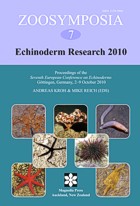Abstract
Onychaster is prominent in discussions on the ancestry of crown group ophiuroids because about half of researchers have classified Onychaster as a Palaeozoic representative of the living Order Euryalida. With this classification there is a Mississippian to Cretaceous gap in the euryalid fossil record. Other researchers have classified Onychaster as non-euryalid, in which case there is no such gap. This undecided status is an important reason to review the classification of Onychaster using new observations. In Onychaster the lateral plates are strictly on the underside of the arm where they form a double row and nearly touch midventrally; there are no mid-ventral underarm plates. The undersurface-laterals bear a transverse row of spines that point proximally (in retro-direction). The disk in large specimens bulges interradially such that the arms insert subambitally. The morphology of Onychaster vertebrae is documented anew in SEM stereo-pair images. Distinctive features include: a median dorsal cleft or circular pit on the upper surface; an auluroid canal; paired epanapophyses; a zygosphene dorsal to the auluroid canal; exceptionally spacious fossae for the ventral longitudinal muscles; and an undersurface plastron that is dimensioned like a waist belt. These features are transformationally close to eospondylid/furcasterid vertebrae and progressively/increasingly distant from zygospondylous, transpondylous, and streptospondylous vertebrae. Classification of Onychaster as an euryalid is not supported. We reclassify the Onychasteridae next to the Furcasteridae.

